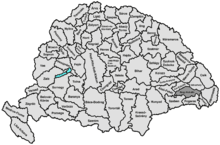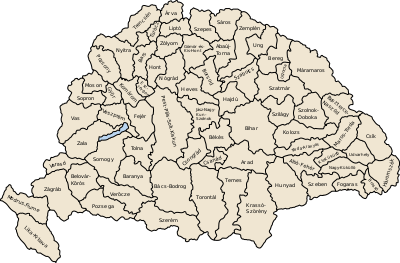Nagy-Küküllő County
Nagy-Küküllő (Romanian: Comitatul Târnava-Mare) was an administrative county (comitatus) of the Kingdom of Hungary. Its territory is now in central Romania (central Transylvania). Nagy-Küküllő is the Hungarian name for the river Târnava Mare. The capital of the county was Segesvár (present-day Sighișoara).
| Nagy-Küküllő County | |
|---|---|
| County of the Kingdom of Hungary | |
| 1876–1920 | |
.svg.png) Coat of arms
| |
 | |
| Capital | Segesvár |
| Area | |
| • Coordinates | 46°13′N 24°48′E |
• 1910 | 3,337 km2 (1,288 sq mi) |
| Population | |
• 1910 | 148800 |
| History | |
• Established | 1876 |
• Treaty of Trianon | 4 June 1920 |
| Today part of | |
| Sighișoara is the current name of the capital. | |
Geography
Nagy-Küküllő county shared borders with the Hungarian counties Alsó-Fehér, Kis-Küküllő, Udvarhely, Háromszék, Brassó, Fogaras and Szeben. The river Nagy-Küküllő formed part of its northern border, the river Olt part of its southern border. Its area was 3337 km² around 1910.
History
Nagy-Küküllő county was formed when the county of Küküllő was split in 1876, when the administrative structure of Transylvania was changed. In 1920, by the Treaty of Trianon the county became part of Romania. Its territory lies in the present Romanian counties Sibiu (the west), Brașov (the south-east) and Mureș (around Sighișoara).
Demographics
In 1900, the county had a population of 145,138 people and was composed of the following linguistic communities:[1]
Total:
- Romanian: 61,779 (42.6%)
- German: 61,769 (42.5%)
- Hungarian: 17,139 (11.8%)
- Croatian: 177 (0.1%)
- Slovak: 76 (0.1%)
- Serbian: 17 (0.0%)
- Ruthenian: 7 (0.0%)
- Other or unknown: 4,181 (2.9%)
According to the census of 1900, the county was composed of the following religious communities:[2]
Total:
- Lutheran: 61,777 (42.6%)
- Eastern Orthodox: 50,350 (34.7%)
- Greek Catholic: 16,259 (11.2%)
- Calvinist: 7,651 (5.3%)
- Roman Catholic: 5,105 (3.5%)
- Unitarian: 2,889 (2.0%)
- Jewish: 1,092 (0.7%)
- Other or unknown: 15 (0.0%)

In 1910, county had a population of 148,826 people and was composed of the following linguistic communities:[3]
Total:
- German: 62,224 (41.8%)
- Romanian: 60,381 (40.6%)
- Hungarian: 18,474 (12.4%)
- Slovak: 63 (0.0%)
- Croatian: 57 (0.0%)
- Ruthenian: 6 (0.0%)
- Serbian: 4 (0.0%)
- Other or unknown: 7,617 (5.1%)
According to the census of 1910, the county was composed of the following religious communities:[4]
Total:
- Lutheran: 62,370 (41.9%)
- Eastern Orthodox: 51,622 (34.7%)
- Greek Catholic: 17,145 (11.5%)
- Calvinist: 8,320 (5.6%)
- Roman Catholic: 5,402 (3.6%)
- Unitarianist: 3,222 (2.2%)
- Jewish: 1,089 (0.7%)
- Other or unknown: 16 (0.0%)
Subdivisions
In the early 20th century, the subdivisions of Nagy-Küküllő county were:
| Districts (járás) | |
|---|---|
| District | Capital |
| Kőhalom | Kőhalom, RO Rupea |
| Medgyes | Medgyes, RO Mediaș |
| Nagysink | Nagysink, RO Cincu |
| Segesvár | Segesvár, RO Sighișoara |
| Szentágota | Szentágota, RO Agnita |
| Urban districts (rendezett tanácsú város) | |
| Medgyes, RO Mediaș | |
| Segesvár, RO Sighișoara | |
References
- "KlimoTheca :: Könyvtár". Kt.lib.pte.hu. Retrieved 6 December 2012.
- "KlimoTheca :: Könyvtár". Kt.lib.pte.hu. Retrieved 7 December 2012.
- "KlimoTheca :: Könyvtár". Kt.lib.pte.hu. Retrieved 20 June 2012.
- "KlimoTheca :: Könyvtár". Kt.lib.pte.hu. Retrieved 20 June 2012.
